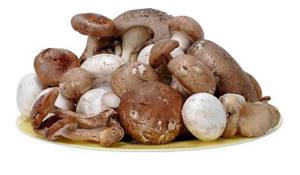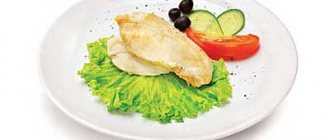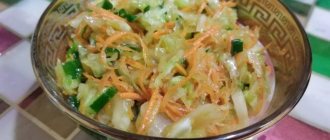Chemical composition
Mushrooms contain substances that have an extremely positive effect on the human body. But an approximate table of product composition:
| Components | Approximate amount for every 100 grams |
| Vitamins |
|
| Microelements |
|
| Macronutrients |
|
| Fatty acid | Omega 6 - about 0.5 g |
| Cellulose | From 2.5 to 4 g |
| Saturated fatty acids |
|
| Monounsaturated fatty acids | Omega 9 - about 0.030 g |
| Polyunsaturated fatty acids | Linoleic acid – not less than 0.5 g |
| Sahara | No more than 0.1 g |
| Ash | No more than 1 g |
| Water | 90 to 92% |
The high nutritional value of the product is represented by the ratio of proteins, fats and carbohydrates (BJU), which is 4.5/1/0.2 g per 100 grams. The energy value largely depends on the type of mushroom and ranges from 25-40 kcal for every 100 grams.
Calorie content also depends on the method of preparation of the product:
| Cooking method | Approximate number of calories |
| Pickled | Within 40-45 kcal |
| Dried | From 120 to 200 kcal depending on the type |
| Salty | No more than 30 kcal |
| Boiled | Within 50 kcal with minor deviations |
| Stewed | From 70 to 150 kcal depending on additional ingredients |
| Fried | From 75 to 180 kcal |
This difference in calorie content is explained by different varieties of mushrooms, since some of them are high-calorie, while others have minimal energy value.
Beneficial features
A large amount of protein makes the product no less healthy than poultry meat. The benefits of mushrooms are as follows:
- have antibacterial, anti-inflammatory and mild diuretic properties;
- normalize metabolic processes and promote slow, safe weight loss;
- stimulate tissue regeneration processes;
- relieve headaches, eliminate tinnitus;
- strengthen the vascular wall and reduce capillary permeability;
- prevent the deposition of cholesterol plaques and the development of atherosclerosis;
- improve myocardial functioning and prevent heart failure;
- normalize blood pressure numbers, prevent its sharp jumps;
- stimulate the production of digestive enzymes and bile;
- prevent stagnation in the gallbladder and the formation of cholesterol stones;
- strengthen bones and teeth;
- improve psycho-emotional state, prevent stress, depression, insomnia;
- improve memory and concentration;
- promote the removal of harmful compounds from the body;
- have a beneficial effect on joints with arthritis and arthrosis, relieve acute symptoms of pathology;
- relieve fatigue after prolonged exercise;
- help improve and maintain visual function;
- strengthen the immune system and prevent frequent viral and cold pathologies;
- replenish the deficiency of minerals and vitamins;
- slow down the growth and development of atypical cancer cells.
The product is useful for men because it prevents pathologies of the urinary system, stimulates sexual function and prevents its early decline, increases endurance and physical strength, and promotes muscle growth during intense sports.
For women, mushrooms are valuable because they normalize hormonal levels, the menstrual cycle, relieve unpleasant symptoms during menopause, help strengthen nails and strands and help maintain healthy skin. The antioxidant properties of the product help slow down the aging process and prevent the loss of elasticity of the epidermis.
Contraindications and possible harm
In some cases, the product may be harmful to health. Main contraindications:
- severe form of gastritis with low acidity of gastric juice;
- peptic ulcer in the acute stage with the threat of perforation of the stomach wall;
- chronic or acute pancreatitis with severe pain;
- acute stage of gout;
- individual intolerance;
- end stage renal failure;
- enteritis and colitis in the acute stage;
- severe form of liver cirrhosis and liver failure;
- indigestion;
- elderly age;
- persistent constipation.
Pregnancy and breastfeeding are not considered a contraindication, but the product should only be used in doses and with the permission of the attending physician. Children under 5 years old should not be given mushrooms in any form, since the child’s body does not produce the special enzymes that are necessary to digest them.
If the recommendations are not followed, a person often develops side effects in the form of pain and heaviness in the stomach, spasms of intestinal smooth muscles, constipation, nausea, vomiting, and headache. Such a reaction can be the result of overeating or poisoning with a low-quality product or a violation of cooking technology.
Allergy to mushrooms is manifested by itching, burning, peeling, and rash on the skin. If such symptoms occur, it is recommended to stop using the product and seek qualified help.
Common types
According to scientists, there are more than 100 thousand species of mushrooms in nature. But not all varieties are eaten. There are several species that are common in Russia and are cultivated artificially.
White
Porcini mushroom, or boletus, is considered the most valuable type of mushroom because it has unique taste and beneficial properties. The species is quite large, has juicy flesh and grows up to 15 cm in length with a cap diameter of 20 cm. It grows under birch, oak, and pine trees.
A distinctive feature of this species will be the white flesh, which does not change when cut and emits a pleasant smell. You can distinguish boletus mushrooms from other similar mushrooms by the skin on the cap, which cannot be removed. The variety is ideal for stewing, frying, drying or pickling.
Chanterelles
Chanterelles are easy to distinguish from other species by their unique cap shape and orange color. Another feature will be the mucous surface, dense body and leg. Chanterelles grow up to 4 cm in height with a cap diameter of up to 5 cm. They are most often found in grassy areas with good access to sunlight. Chanterelles do not grow in the forest.

In cooking, a similar variety is used boiled, stewed, fried, pickled and salted.
Oyster mushrooms
A fairly common variety, growing in groups on the trunks of weakened or almost dried out trees. You can find them on birch, oak, pine, and rowan trees. With a stalk that reaches a maximum length of 5 cm, the mushroom has a cap up to 30 cm in diameter. The pulp is juicy, white or yellowish.
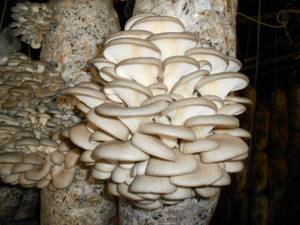
As the flesh ages, it loses its elasticity and juiciness. For this reason, only young oyster mushrooms are eaten. This species is suitable for various processing methods and is actively cultivated in many countries.
Honey mushrooms
Honey mushrooms are distributed everywhere and prefer to grow close to tree trunks or directly on them. Often found on dead trunks or stumps. They are small in size, the cap rarely reaches a diameter of more than 10 cm, and the leg grows no more than 8 cm. They resemble chanterelles in color.
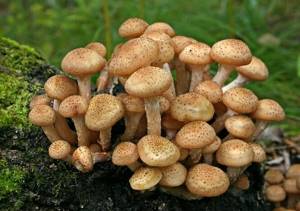
Honey mushrooms are actively used in cooking for cooking, drying, stewing, pickling, and pickling. They have juicy pulp.
Champignon
Champignons are a popular type of mushroom, since they are not only actively collected by mushroom pickers, but also cultivated under artificial conditions. They have a dense stem no more than 5 cm long, a cap that reaches 20 cm in diameter. The flesh is white when cut, but darkens after a few minutes in the open air.
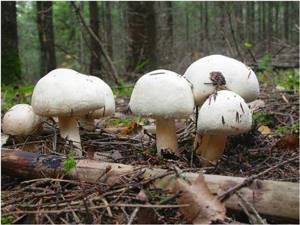
The mushroom exudes a pleasant aroma and tastes very juicy. Under natural conditions it grows in forests and open grassy areas. Suitable for any processing method and less likely than other types to cause indigestion, allergies, and other unpleasant symptoms.
Boiled mushrooms recipe
To do this, you only need water, the main product, salt, bay leaf, and a couple of black peppercorns.
Steps:
- Clean the legs from leaves and blackness.
- Rinse, but not with too much water, as this product absorbs liquid very quickly.
- Cut into small pieces.
- Cook for approximately 20 minutes after boiling.
- Then place on a sieve and rinse under cold water. The dish is ready!
What do you need to know when cooking?
- If you put an onion in water with a product and it darkens, it means there is a poisonous mushroom there.
- Add a bay leaf and the aroma will be much nicer.
- How to check that mushrooms are cooked? Just! They sink to the bottom rather than float to the surface.
Some features
Mushrooms are prepared in several ways depending on gastronomic preferences. It is not recommended to eat the raw product, as it tends to accumulate radioactive substances in large quantities. Most often, mushrooms are subjected to the following processing methods:
- Marinating and salting. Most often, champignons, oyster mushrooms and honey mushrooms are pickled and salted using salt, vinegar, and various spices. It is not recommended to make the marinade too sour. This product should not be consumed by people with any problems of the digestive system.
- Cooking - more often used when preparing soups or other first courses. Allows you to make the product safe, suitable for any type. Depending on the type of mushroom, the cooking time differs, approximately 15-60 minutes.
- Frying and stewing with the addition of spices or other ingredients. Allows you to use any variety of mushrooms and prepare various dishes. It is recommended to boil the product before frying. Cooking time depends on its type.
Drying is considered one of the best ways to prepare mushrooms. Any of the types is allowed to be dried, but only the white mushroom does not acquire a slight bitterness when dried. This method allows you to prepare the product for the winter and preserve all the beneficial properties. It is better to use dry mushrooms for preparing first courses. Properly dried raw materials can be stored for more than 2 years.
Before drying, mushrooms should be sorted and cut into slices. Drying is allowed in the open air, using an oven, electric dryer or microwave. Store in paper bags or jars with an airtight lid.
The recipe for this dish
You need to take half a kilogram of mushrooms, three tablespoons of vegetable oil, a large onion (if you like this product), half a teaspoon of salt.
- Before cooking over the fire, wash the mushrooms and cut them into small pieces.
- Then boil in salted water. Pour into a sieve and fry in a frying pan for about half an hour.
- Ten minutes before readiness, add chopped onion. You can add sour cream, but the dish will be higher in calories and fat.
Bon appetit!
It is important to know that all lamellar mushrooms must first be soaked and then boiled. Only after these steps can you proceed to frying. If you do not follow these steps, you may be poisoned!

Rules of use
The product is allowed to be used no more than 2 times a week. The amount is determined individually and depends on the person’s health status and possible complications after administration. For an adult, 100-150 g at a time is enough. During pregnancy and lactation, it is worth limiting this amount to 50 g per dose.
Children over 5 years old are allowed no more than 1 piece and no more than 2 times a week. Those who suffer from chronic digestive disorders should carefully monitor their condition when consuming the product and limit themselves to 40-50 g. Frequent use will certainly cause complications.
Boiled, stewed and dried mushrooms in moderate quantities will be the most useful. Salted, fried and pickled foods are best consumed rarely and in small portions. Currently, artificially cultivated mushrooms will become safer and healthier, especially for residents of large cities with a large number of industrial enterprises located nearby.
It is allowed to consume wild mushrooms collected by specialists in this field and in places remote from enterprises, highways and people’s homes. Only such a product is safe and healthy. In other cases, it is better to give preference to store-bought, artificially cultivated mushrooms.
Favorite dish of many
Almost everyone loves such a product as mushrooms. This delicacy will help diversify your table and, of course, your diet. Some people love to collect, others love to cook, but both prefer to eat. Cooking a real and delicious dish is not so easy, you need to know some secrets. I’m especially interested in whether it’s possible to consume this delicacy while on a diet? It's interesting to know such useful information.
